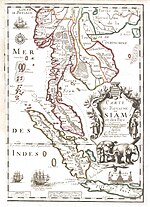Early history of Thailand
| History of Thailand |
|---|
 |
|
|
The known early history of Thailand begins with the earliest major archaeological site at Ban Chiang. Dating of artifacts from this site is controversial, but there is a consensus that at least by 3600 BCE, inhabitants had developed bronze tools and had begun to cultivate wet rice, providing the impetus for social and political organisation.
Later, Malay, Mon, and Khmer civilisations flourished in the region prior to the domination of the Thais, most notably the kingdom of Srivijaya in the south, the Dvaravati kingdom in central Thailand, and the Khmer Empire based at Angkor.
The Thai are part of a larger ethno-linguistic group known as the
During the first millennium CE the Tai peoples were loosely organised in small entities known as in the 13th century.
Phongsawadannuea (Chronicle of the North) is a historical record of this period. The date of its first compilation is unknown, but its content stretches from 500 CE down to the early 11th century. The recent edition was compiled in early
See also
References
- Charles Higham. Prehistoric Thailand. ISBN 974-8225-30-5
